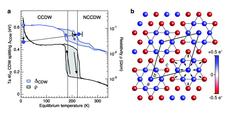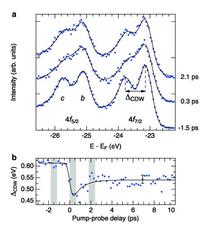Figure 1: Charge-density-wave (CDW) phases of 1T-TaS2. a Equilibrium phase diagram below 340 K displaying the nearly commensurate (NC) and fully commensurate (C) CDW phases. The temperature dependencies of the electrical in-plane resistivity (black line, [4]) and of the CDW-induced Ta 4f core-level splitting ΔCDW (blue line, [5]) show a pronounced hysteresis around the NCCDW-CCDW transition. The open and filled blue circles connected by the dotted arrows mark the transient CDW states observed in the pump-probe photoemission experiments. b Schematic of the Ta atom layer in the CCDW phase showing 13-atom David-star clusters with the three inequivalent Ta sites a, b, and c. The black arrows indicate the displacement of the Ta atoms from their original positions. The electron density increases towards the center of the cluster as illustrated by the color scale.
Stefan Hellmann1, Martin Beye2, *, Christian Sohrt1, Timm Rohwer1, Florian Sorgenfrei2, Harald Redlin3, Matthias Kalläne1, Martin Marczynski-Bühlow1, Franz Hennies4, Michael Bauer1, Alexander Föhlisch2, †, Lutz Kipp1, Wilfried Wurth2, and Kai Rossnagel1
1. Institute for Experimental and Applied Physics, University of Kiel, 24098 Kiel, Germany
2. Institute for Experimental Physics and Center for Free-Electron Laser Science, University of Hamburg, 22761 Hamburg, Germany
3. Deutsches Elektronen-Synchrotron, DESY, 22607 Hamburg, Germany
4. MAX-lab, Lund University, Lund, Sweden
*Present address: Helmholtz-Zentrum Berlin für Materialien und Energie, Berlin, Germany.
†Present address: Helmholtz-Zentrum Berlin für Materialien und Energie, Berlin, Germany and Universität Potsdam, Potsdam, Germany.
Published as: “Ultrafast Melting of a Charge-Density Wave in the Mott Insulator 1T-TaS2”, Physical Review Letters 105, 187401 (2010).
The combination of an optical laser with FEL pulses from FLASH in a pump-probe setup uniquely enables timeresolved core-level photoemission spectroscopy with high temporal and energy resolution. In a proof-ofprinciple experiment, a charge-density wave in the layered strongly correlated electron material 1T-TaS2 is driven out of equilibrium by an intense optical laser pulse and the subsequent nonequilibrium dynamics is probed by FLASH pulses on the sub-picosecond time scale. The results establish FLASH as an ultrafast movie camera for electronic structural dynamics at the surfaces of solids.
When people hear the word “FEL” they usually think of molecular movies, of the exciting possibility to determine molecular structures in a single shot and to follow the motion of atoms in real time. Yet equally fascinating is the idea to use the unique characteristics of FEL radiation to make ‘electronic movies’, i.e., to directly observe what the electrons are doing on the ultrafast time scale. Here the method of choice is time-resolved pump-probe spectroscopy: an intense optical laser pulse excites electrons collectively and the electron dynamics leading the system back to equilibrium is monitored at different time delays by an ultrashort XUV probe pulse. Intriguingly, with the use of FEL probe pulses in the soft X-ray regime, a “complete experiment” becomes possible as not only the valence electrons but also the core electrons can be accessed spectroscopically.
A productive test bed for the application of this technique can be found in low-dimensional materials, in which the charge and lattice degrees of freedom interact strongly such that at low temperatures a so-called charge-density wave (CDW) is formed: a static periodic modulation of the conduction electron density which is always accompanied by a periodic lattice distortion (PLD). Regarding the dynamics of this broken-symmetry ground state, a simple question one can ask is: How and how fast do charge and lattice order melt after impulsive excitation?
Employing time-resolved FLASH photoemission spectroscopy [1], we have investigated the melting behaviour of broken symmetry in the layered model compound 1T-TaS2 [2,3]. The simplified equilibrium phase diagram is plotted in Fig. 1a. At temperatures below about 180 K the system is in a long-range ordered commensurate CDW state and upon heating it undergoes a transition into a short-range ordered (domainlike) nearly commensurate CDW phase. As shown by the resistivity curve in Fig. 1a [4], this first-order transition is associated with an abrupt change – with a large hysteresis – from insulating to metallic behaviour. Moreover, the transition is directly observable in corelevel spectroscopy [5]. The CDW distortion is so strong that the shallow Ta 4f5/2 and 4f7/2 core levels (see Fig. 2a, bottom) split due to the distinctively different chemical states of the b and c atoms in the CDW distortion pattern sketched in Fig. 1b. And since the chemical shift ΔCDW strongly depends on the CDW state of the system (Fig. 1 a), this splitting is well suited as a “spectroscopic order parameter” for the time-resolved study.
Our experimental setup consisted of a collinear integration of the facility’s optical laser [6] into the FEL beam path at the plane grating monochromator beamline PG2 [7,8] at FLASH and an ultrahigh-vacuum chamber equipped with a hemispherical electron analyser with CCD detection as well as a liquid helium manipulator cryostat for sample temperatures as low as 10 K. In the time-resolved photoemission experiments, the 3rd harmonic of FLASH provided XUV probe pulses of 156 eV photon energy, while the optical pump pulses had an energy of 1.55 eV at an excitation density of 1.8 mJ/cm2. The overall time and energy resolutions were 700 fs and 300 meV, respectively. Typical Ta 4f photoemission spectra at selected pump-probe delays are depicted in Fig. 2a. Figure 2b shows the core-level splitting ΔCDW, determined from similar spectra, as a function of pumpprobe delay. This time-resolved measurement reveals that the order parameter is reduced quasi-instantaneously after the optical excitation and subsequently recovers partially with a sub-picosecond time constant.
We interpret this result as follows: First, the optical pump pulse promptly heats the electron system to a highly elevated temperature, thereby strongly suppressing the CDW, while the PLD remains frozen. Then, the excess energy in the electron system is transferred to the lattice system via strong electron-phonon coupling, resulting in a delayed thermal melting of the PLD. Remarkably, this implies that the CDW and its accompanying PLD, which are very strongly coupled in equilibrium, are transiently decoupled after photoexcitation on the time scale of electron-phonon thermalisation. Thus, the short answer to the above question is that after impulsive excitation charge and lattice order melt in a two-step process in about one picosecond.
In conclusion, we note that the results highlighted here demonstrate the first direct measurement of charge-order dynamics in a strongly correlated electron material combined femtosecond time resolution and chemical, elemental, and atomic-site sensitivity. The results establish the technique of time-resolved core-level photoemission spectroscopy at FLASH. In the future, this technique will enable us to create detailed movies of local electron dynamics, movies not only of ultrafast phase transitions in strongly correlated electron materials, but also of chemical reactions on solid surfaces.
| References | ||||||||||||||||
|
| Contact information |
|
Kai Rossnagel |
| Further Information |







